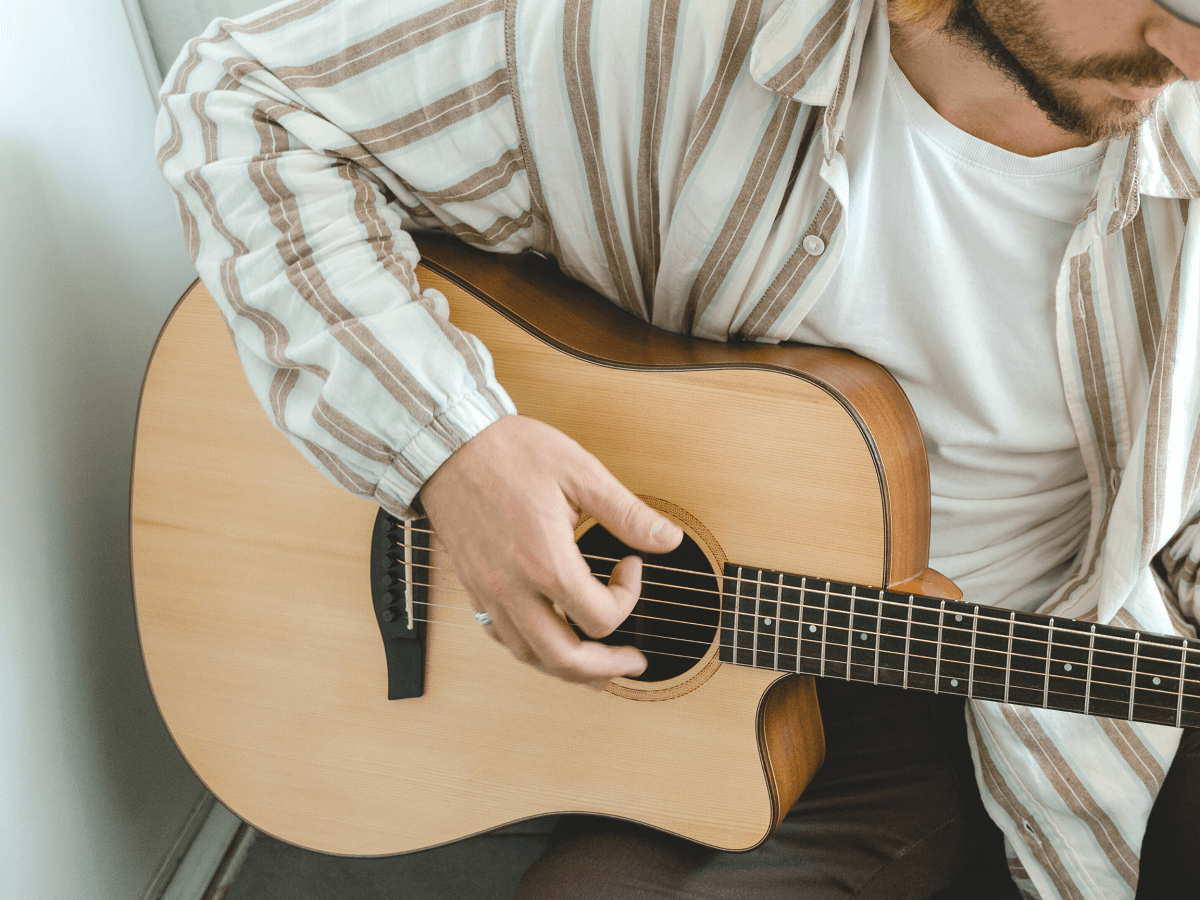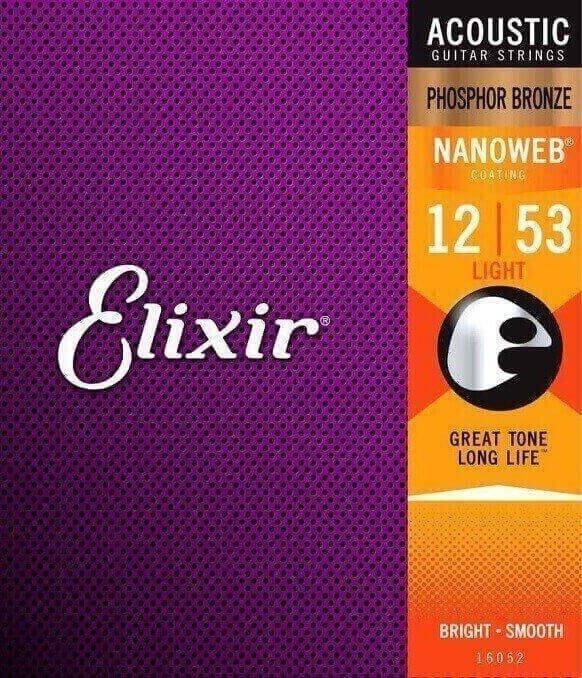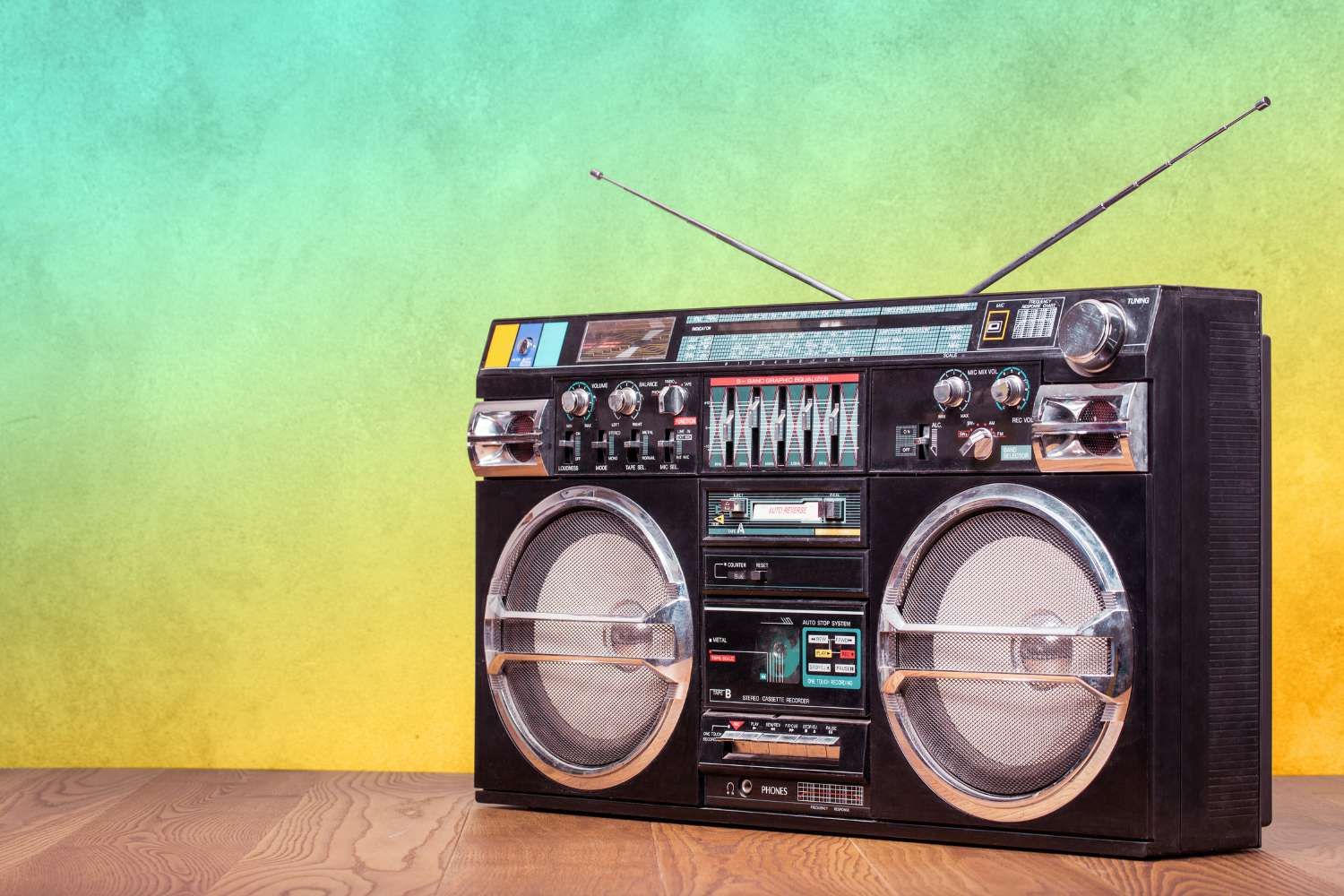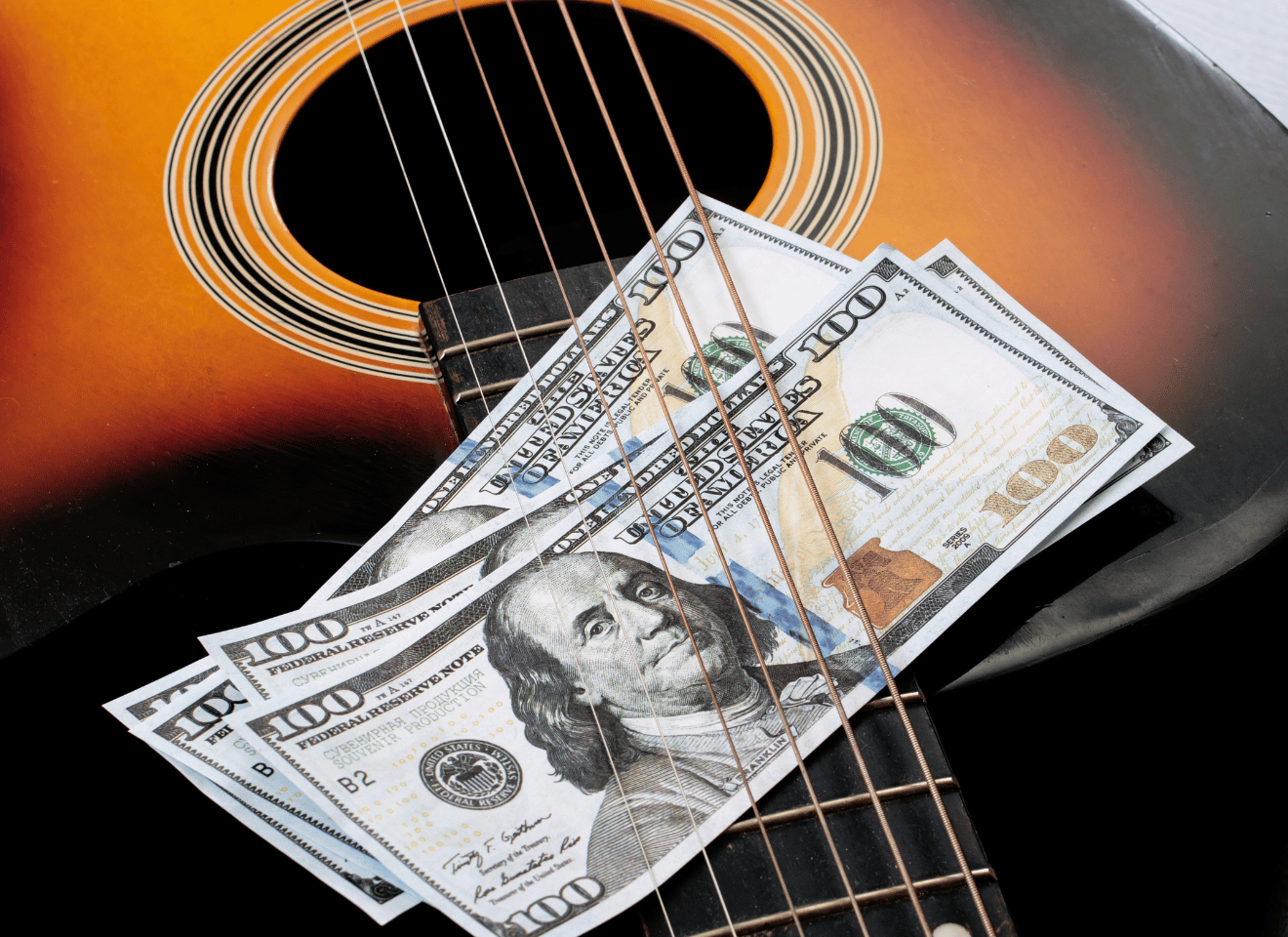There are a lot of acoustic guitars out there that are great for strumming.
Since there are so many different brands and models, it can be tough to decide which one is right for you.
A great strumming guitar needs to be comfortable to play, have a good sound, and be durable enough to withstand a lot of use.
In this blog post, we’ll take a look at some of the best acoustic guitars for strumming in terms of quality, tone, price, and versatility.
We’ll also answer some of the most frequently asked questions on this topic so you can make an informed decision about which guitar is right for you.
So, whether you’re a beginner or an experienced player, read on to find out!
Table of Contents
- Best Acoustic Guitars For Strumming
- What kind of acoustic guitar is good for strumming?
- Which pick size is best for strumming?
- Can somebody with small hands play a regular-sized guitar?
- What’s the best size for an acoustic guitar?
- What to consider before buying an acoustic guitar?
- Tips To Get Better At Strumming
- What is the difference between cheap guitars and expensive acoustic guitars?
- What strings are best for an acoustic guitar?
Best Acoustic Guitars For Strumming
Before I begin, here are my top selected choices:
Taylor Series 418e Grand Orchestra Acoustic-Electric Guitar

Affordable elegance that doesn’t compromise on sound. Check Price
|
|
Yamaha C40II Classical Guitar

Affordable, beginner-friendly with rich, mellow sound. Check Price
|
Taylor Series 418e Grand Orchestra Acoustic-Electric Guitar
Performance-grade tone in a stunning package.
Designed for the stage, this guitar features a Sitka spruce top and ovangkol body for a rich, full-range tone. The ES2 pickup system and 2-band EQ ensure amplified sound is top-notch. Its Grand Orchestra body shape delivers a well-balanced, complex voice, ideal for strumming and rhythm.

The Taylor 400 Series 418e Grand Orchestra Acoustic-Electric Guitar is a high-quality instrument that would be great for strumming.
It features a Sitka spruce top and ovangkol body for a rich, full-range tone, and comes with Taylor’s ES2 pickup system and 2-band EQ for great amplified sound.
This guitar is not your usual beginner guitar; it’s been designed with performance in mind, so its pricing reflects that.
One thing we loved is how the all-gloss body really ties ovangkol’s toasted golden color tones together with the buttery Sitka spruce top.
This combination really brings out the best in the ovangkol wood and makes for a truly beautiful guitar.
Here are the ratings I’ll give to the Taylor Series 418e Grand Orchestra Acoustic-Electric Guitar:
Ovangkol wood for guitars is becoming increasingly popular because it shares a wide tonal spectrum from lows to highs, but with a slightly fuller midrange and a bright treble that resembles koa.
Aside from that, the Grand Orchestra body shape of this guitar delivers a rich, complex voice that is well-balanced for a big-bodied acoustic guitar.
Big-bodied acoustic guitars tend to have a full sound that for the purpose of strumming and filling in the rhythm section in a song is perfect.
- Pros:
- Sitka spruce top for a rich, full-range tone
- Ovangkol body for great sound and looks
- ES2 pickup system for great amplified sound
- 2-band EQ for tailoring your sound
- Cons:
- Not a beginner guitar.
- Pricey for some people
- Might be too big-bodied for some people’s tast
My final verdict is that the Taylor 400 Series 418e Grand Orchestra Acoustic-Electric Guitar is a remarkable high-end guitar.
Its rich tone, balanced sound, and beautiful design seem to be the perfect fit for professional guitarists who wish to produce high-quality music.
Its price point reflects its superior quality and is definitely a worthy investment for musicians.
This guitar truly stands out among its peers due to its use of ovangkol wood, which gives a unique sound that other guitars in the same category may lack.
Yamaha C40II Classical Guitar
Affordable, beginner-friendly with rich, mellow sound.
Designed for beginners, this classical guitar offers a low action for easy playability. The spruce and meranti construction delivers a mellow, rich sound often found in pricier models. Its gloss finish adds a sleek, professional touch.
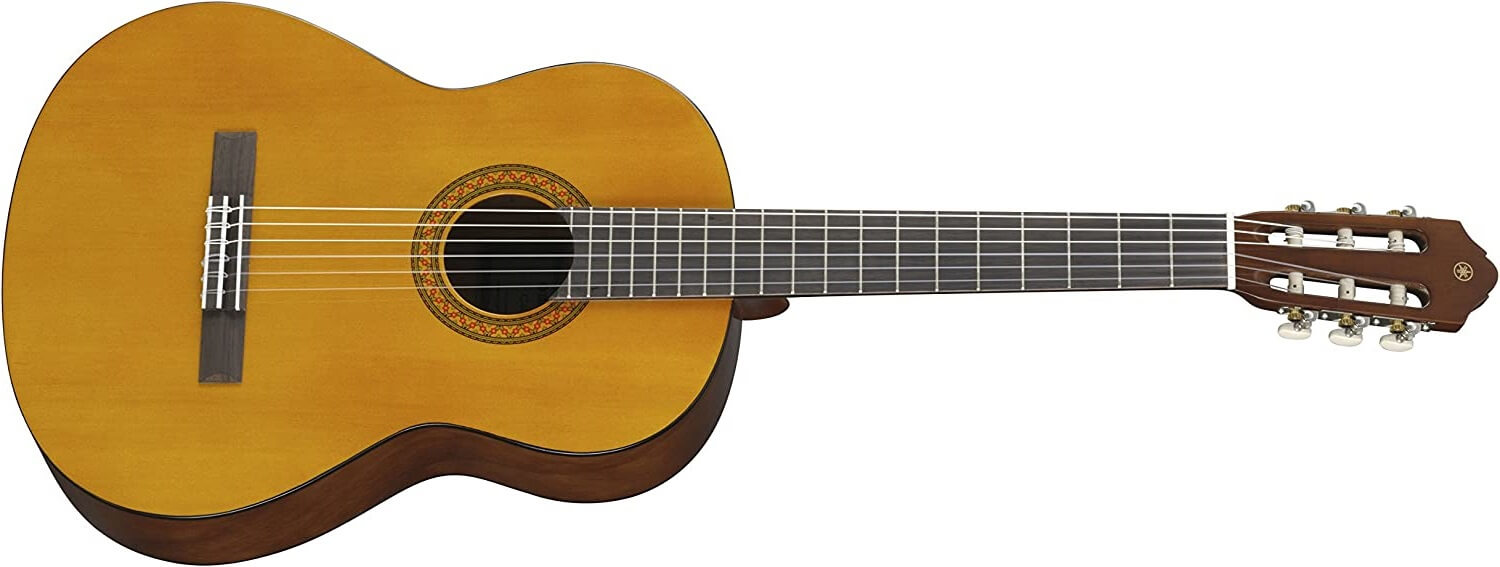
This guitar is a bit more special than the others on this list for the simple reason that it is the only classical guitar that we’ve mentioned so far.
If you’re not familiar with the term, a classical guitar is simply a nylon string acoustic guitar – no electricity is required.
For that reason, they’re sometimes called Spanish guitars or Flamenco guitars.
They’re also quieter than regular acoustic guitars, which makes them ideal for unplugged performances and practice sessions.
Now that we’ve got that out of the way, let’s take a closer look at the Yamaha C40II Classical Guitar.
This guitar is designed specifically and mostly for beginner guitar players.
It features a spruce top with meranti back and sides and a nato wood neck; plus the fingerboard and bridge are made of rosewood.
The C40II also has a gloss finish, which gives it that sleek and professional look that shines like no other.
Here are the ratings I’ll give to the Yamaha C40II Classical Guitar:
What I enjoyed about this guitar is that the action is low, which makes it really comfortable for beginners who are just starting to learn how to play.
Aside from that, the guitar has a really nice, mellow sound that’s often found in more expensive classical guitars.
So if you’re looking for an affordable, beginner-friendly classical guitar, the Yamaha C40II is a great option you should definitely consider.
- Pros:
- Low action makes it comfortable for beginners
- Sleek and professional look
- Great sound for the price
- Cons:
- You might want something better.
My final verdict is that the Yamaha C40II classical guitar is a fantastic choice for beginners.
It’s reasonably priced, and well-constructed, and it offers a pleasing sound quality that rivals much pricier models.
The low action is a big plus, aiding beginners in their learning process by making play comfortable and fairly effortless.
Its attractive and professional appearance adds a touch of class to this entry-level guitar, and it would not be out of place in any collection.
Bristol BD-16 Dreadnought Acoustic Guitar
Rich tone, wallet-friendly craftsmanship.
Offers premium tonewoods without breaking the bank. The forward-X bracing and adjustable truss rod ensure both durability and playability. Chrome-plated tuning heads keep you in tune, minimizing the fuss of constant adjustments.
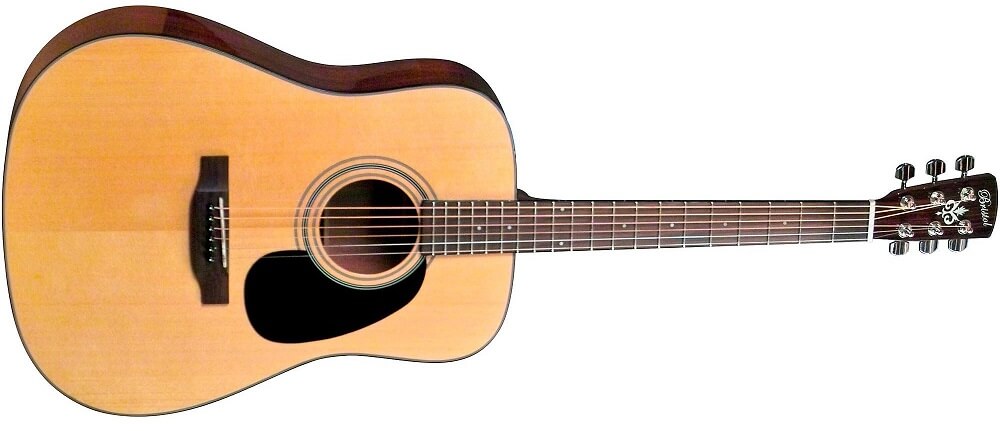
The Bristol BD-16 Dreadnaught by Blueridge is handcrafted with the finest spruce and mahogany tonewoods by experienced artisans.
We decided to include this guitar here for those who are looking for a quality option without having to spend a lot of money.
It features a vintage-designed forward-x top bracing that is lightweight yet strong and a slim mahogany neck with a fully adjustable truss rod.
The result is what they call a traditionally styled dreadnaught guitar with great carrying power, resonance, and a rich tone.
Additionally, the BD-16 comes with chrome-plated 14:1 die-cast machine heads that are decently smooth and precise, so you can always stay in tune and not have to worry about too much maintenance.
This doesn’t mean that the guitar is perfect, but for its price point, it’s a great option if you’re looking for something with such a tone.
Here are the ratings I’ll give to the Bristol BD-16 Dreadnought Acoustic Guitar:
Something we liked about this guitar is that even though it’s affordably priced, Blueridge didn’t cut any corners in terms of construction and materials.
They still use the same spruce and mahogany woods that they use in their more expensive models.
And for those who don’t know, Bristol is a subsidiary of Blueridge, and the latter is currently owned by Saga Musical Instruments, which is a pretty large and reputable company in the music industry.
- Pros:
- Handcrafted with high-quality spruce and mahogany tonewoods
- Vintage forward-x top bracing is strong and lightweight
- Slim mahogany neck for fast and easy action
- Fully adjustable truss rod guarantees perfect alignment
- Cons:
- May not be suitable for those with larger hands
My final verdict is that the Bristol BD-16 Dreadnought is a standout among budget-friendly guitars.
Its fine craftsmanship, quality materials, and great sound make it a worthy investment.
Despite its affordable price, its quality and performance can rival that of more expensive guitars.
It is clear that Bristol and Blueridge, under the Saga Musical Instruments company, have committed to delivering a product that does not compromise on quality for affordability.
Martin DJr-10E Acoustic Guitar
Compact size, big on sound.
Solid wood construction meets ergonomic design for exceptional sound and playability. Features like ¼ inch scalloped bracing and a high-performance tapered neck elevate the instrument beyond beginner levels. Comes pleked for precision and includes a soft gig bag for easy transport.

The Martin DJr-10E Acoustic Guitar is a smaller guitar that people with small hands could find easier to play.
It is made with solid wood construction and ¼ inch scalloped bracing for a big sound.
The comfort edge and smaller body make it very super easy and comfortable to play.
The guitar is also pleked for precision and comes with a soft gig bag as an extra.
You can also add optional electronics to this guitar if you want.
Another thing I liked was that it came with a high-performance tapered neck which is great for playability.
Here are the ratings I’ll give to the Martin DJr-10E Acoustic Guitar:
I didn’t feel like it was hard to hold, play or put down like some other guitars.
So all in all, if you are looking for a great starter guitar that will last way beyond beginer’s level, the Martin DJr-10E Acoustic Guitar is a great choice.
- Pros:
- Solid wood construction for a great sound
- ¼ inch scalloped bracing for a big sound
- Comfort edge for easy and comfortable playing
- Smaller body perfect for people with small hands
- Cons:
- Overall, for the purpose of small hands, none!
My final verdict is that the Martin DJr-10E Acoustic Guitar is an exceptional option for beginners with small hands and even intermediate players.
With its durability, quality construction, and added features, this guitar is definitely worth the investment.
Gibson J-185 Acoustic Guitar
Sound and craftsmanship, worth every penny.
Boasts a Sitka spruce top and flame maple back for unparalleled acoustic resonance. The LR Baggs VTC pickup offers dynamic electric sound. Its nitro finish and high-end construction make it a durable, long-term investment.
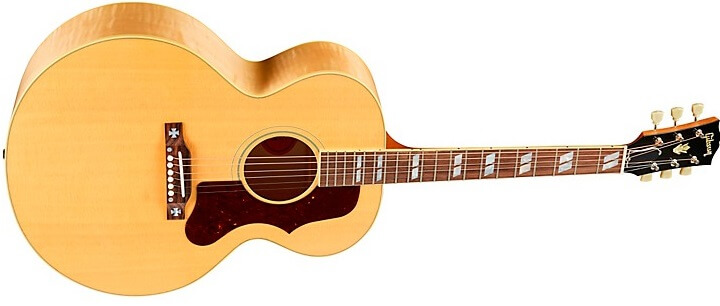
The Gibson J-185 Acoustic Guitar is an amazing choice for country music.
It has a Sitka spruce top, flame maple back and sides, and a slim taper mahogany neck.
The rosewood fingerboard has mother-of-pearl parallelogram inlays and the guitar also features Gotoh Keystone tuning machines.
The LR Baggs VTC under saddle pickup with volume and tone controls that it has gives the J-185 an amazing electric sound.
On the other hand, its nitro-finished body makes this guitar not only look great but also protects it from wear and tear, which makes it a perfect investment.
The J-185 is the perfect body size and shape for any player, whether you’re an intermediate player or a pro.
Here are the ratings I’ll give to the Gibson J-185 Acoustic Guitar:
Now, this instrument is on the high-end of pricing, and when I say this, I really mean it.
But, for what you’re getting in return – an amazing guitar with a great sound that will last you a lifetime – the J-185 is definitely worth the investment.
Other specifications include that it has a traditional hand-scalloped X-bracing, is right-handed, and has a scale length of 24.75″.
- Pros:
- Great for country music
- Sitka spruce top, flame maple back and sides
- Slim taper mahogany neck
- Rosewood fingerboard, mother-of-pearl parallelogram inlays
- Gotoh Keystone tuning machines
- Cons:
- Very high-end pricing.
My final verdict is that despite being on the pricier end, the Gibson J-185 Acoustic Guitar represents a fantastic investment for both pro and intermediate players.
With its excellent build, rich and warm sound, and durability, this instrument is more than worth its cost.
The stunning aesthetics add to the overall package, making it not just a musical instrument, but also a work of art.
Therefore, if you’re looking for a guitar with exceptional qualities and longevity, the Gibson J-185 Acoustic Guitar could be your perfect choice.
Ovation CS24P Acoustic-Electric Guitar
Tonally rich and visually captivating.
Boasting a Figured Koa top and mid-depth cutaway body, this guitar delivers a full, nuanced sound that resonates deeply. Aesthetically, the abalone rosette and unique headstock turn heads and captivate eyes. The onboard preamp and EQ system allow for intricate sound customization.
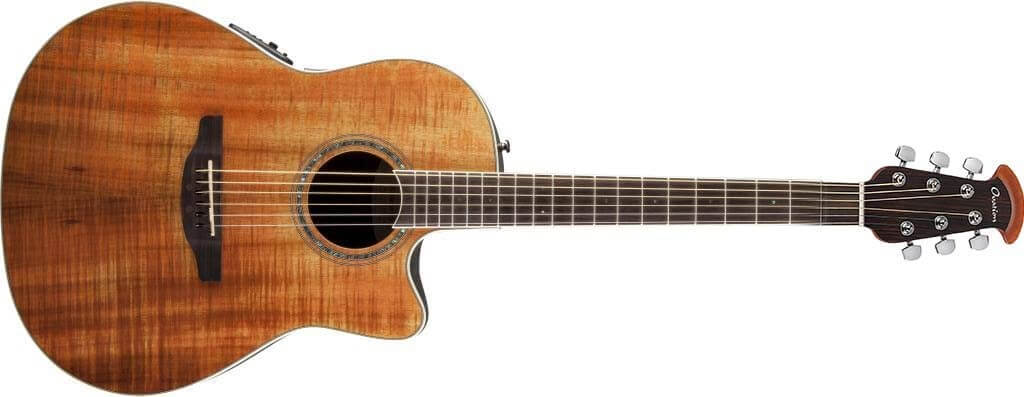
The Ovation CS24P Acoustic-Electric Guitar is a top-quality acoustic guitar that is perfect for those who are looking for an instrument that looks as good as it sounds.
This guitar features a Figured Koa top with quartersawn scalloped “X” bracing, an elegant abalone rosette, and ivory white binding.
Its body is a mid-depth cutaway with a natural satin finish and rosewood-veneer headstock.
Said headstock has a particularly unique look to it when you stand in front of the guitar, almost as if it was wearing a helmet, which I really liked.
When it comes to sound, the overall tone of the guitar is nuanced and complex with full projection, remarkable note clarity, and balance.
Aside from that, the guitar also features a 20-fret bound rosewood fretboard with abalone microdot inlays and a rosewood bridge.
Here are the ratings I’ll give to the Ovation CS24P Acoustic-Electric Guitar:
It also comes equipped with an Ovation Slimline pickup and OP-4BT preamp system with three-band EQ, volume/gain control, onboard tuner, and low-battery control light.
For those of you looking for a guitar that is both stylish, sounds great, and is decently good for strumming, then this one must be on your radar.
- Pros:
- Attractive design
- Features a pickup and preamp system
- Figured Koa top with quartersawn scalloped “X” bracing
- Cons:
- Some people might not like its body shape
My final verdict is that the Ovation CS24P Acoustic-Electric Guitar is a fantastic instrument to add to your collection.
The combination of its stunning appearance and high-quality sound makes it a must-have for any serious musician.
Not only does it offer unique aesthetics due to its Figured Koa top and rosewood-veneer headstock, but its advanced pickup and preamp system also provides an excellent range of tonal options.
Fender FA-115 Dreadnought Acoustic Guitar
Versatile tone, beginner-friendly bundle.
Spruce top with “X” bracing delivers versatile, dynamic sound suitable for various playing styles. The guitar comes as a complete bundle, offering everything a beginner needs to start playing immediately. Quality construction and player-friendly features make for a resonant and balanced tonal output.

This Fender FA-115 dreadnought acoustic guitar features a Spruce top with “X” bracing, basswood back and sides, Nato wood neck, and a 20-fret walnut fretboard.
Spruce is known by many as the standard tonewood for acoustic guitar tops since only a few kinds of wood can get close to beating it in strength and dynamic range.
Aside from that, with this unit, you will also get a laminated body material, chrome hardware finish, a 25.3″ (643 mm) scale length, and a fixed guitar bridge system.
When it comes to aesthetics, white bridge pins with black dots, covered chrome tuning machines, dot position inlays, and a black pickguard are some of the things that make this guitar look incredibly good.
To add more value, this model usually comes as a bundle, which includes everything you need to start playing immediately: a gig bag, an easy-to-use clip-on tuner, a strap, extra strings, picks, and an Austin Bazaar instructional DVD.
Here are the ratings I’ll give to the Fender FA-115 Dreadnought Acoustic Guitar:
Other player-oriented features are its tone-enhancing bridge with compensated saddle, and quality construction built for the ultimate full and resonant sound.
- Pros:
- Sturdy and durable construction
- Excellent tone and sound quality
- Comes with a bundle of accessories
- Great for beginners and professionals alike
- Cons:
- Action being too high out of the box, but this is fixable
My final verdict is that the Fender FA-115 is an excellent choice for both beginner and intermediate players.
It not only offers a fantastic sound and build quality but also a range of impressive features at an affordable price.
The included bundle makes it an especially good value, providing everything a new player needs to get started right away.
What kind of acoustic guitar is good for strumming?
There is no definitive answer to this question since it depends on personal preference.
However, some people tend to prefer guitars with a bit more weight and a fuller sound for strumming purposes.
What this means is that the bigger the body of the guitar, the more likely it is for this to be possible.
You’ll want to look out for guitars with a bigger sound hole as well since this usually provides a louder and fuller sound.
There are a few different types of guitars that are often recommended for strummings, such as dreadnought or jumbo acoustic guitars.
Also, there’re many great options from different brands, so it really comes down to finding the right one that suits your needs.
It can also be helpful to have a guitar with slightly thicker strings since this can make strumming easier to be heard.
This combination of body, strings and the sound hole is what will set you up for success in terms of getting a good sound when strumming the guitar.
Which pick size is best for strumming?
I’ve found that thicker picks are best for strumming because they help to produce a clear and sharper sound.
The only exception is whether you require more control over what you play or not, in that case, thinner picks are also great.
Thin picks can work well but they tend to produce a relatively thinner sound.
When it comes to the pick’s material, you can opt for either plastic or wood.
Plastic picks are less expensive, but they also wear down faster.
On the other side, wood picks are more durable, but they’re also usually more expensive.
Ultimately, it’s up to you to decide which pick size and material are best for your needs, but I’d say, experiment with different options until you find the perfect combination for you.
Additionally, you can just use your fingers to strum the strings, which will also sound good and give you a lot of room for experimentation.
This YouTube video by Tomas Michaud is a great resource that covers whether to use a pick or your fingers for strumming
He mentions how different strings and guitars call for different techniques so it’s important to be versatile.
More importantly, take a second to hear the difference between the two so you can make a decision for yourself on which sound you like the most.
Can somebody with small hands play a regular-sized guitar?
Yes, but it might be more difficult to play certain chords and achieve the same level of comfort as someone who is playing a guitar that is sized specifically for small hands.
If you have small hands, we recommend checking out some of the best acoustic guitars for small hands that we listed above.
These guitars are designed to be more comfortable for those with smaller hands and will make it easier to play chords and achieve the sound you want.
Most people, with a bit of time and practice, can learn to play a regular-sized guitar just fine.
However, if you want to make things easier on yourself (and have more fun while playing), we recommend going with a guitar that is sized specifically for small hands.
What’s the best size for an acoustic guitar?
Generally, most adults don’t have a problem with full-size guitars.
But if you, for example, have very small hands, then you need to consider a smaller guitar, something like Parlors, Concerts, or 3/4 sized guitars.
Read: Do You Need Big Hands to Play Guitar?
There is not such a thing as “best size for a guitar”, but there will always be a size that will suit you the most.
Only you know which one that is, and if you don’t then the best way to find out is to try a lot of guitar and see which ones suits you better.
I have found a great video by Acoustic Letter, where they talk about this in more detail:
What to consider before buying an acoustic guitar?
Before purchasing an acoustic guitar, it is important to consider the following factors:
– The guitar body
Buying a new guitar shouldn’t be complicated, but you might want to pay attention to a few small details that later on might affect the way you play tremendously.
If you’re buying a new guitar, then you should know that the body shape of your guitar will have a huge influence on what tone and volume you will get when playing and possibly how comfortable you feel.
These are some of the most popular guitar body shapes that you encounter:
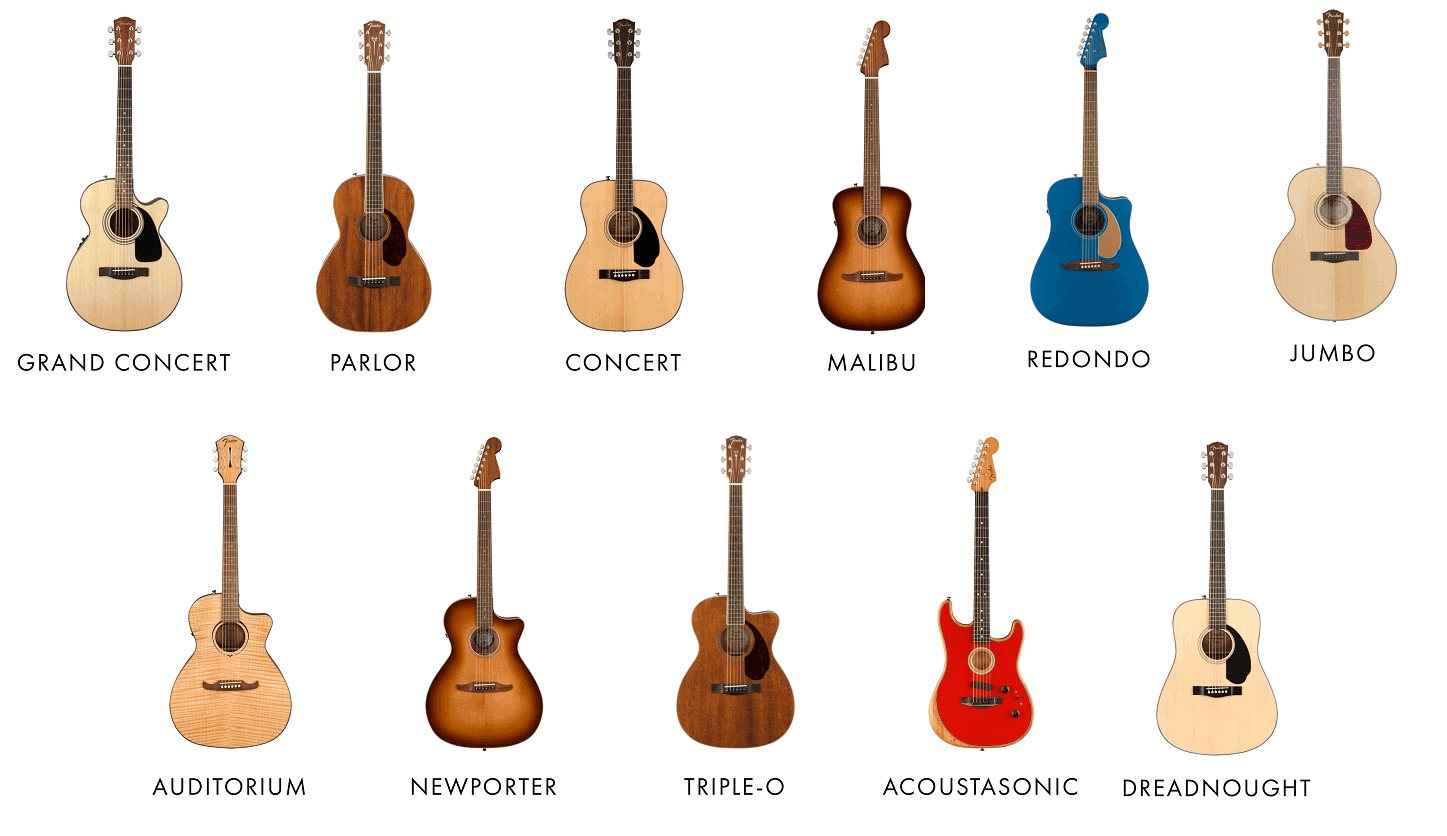
For this specific post, talking about each body style and their advantages and disadvantages go beyond the scope of the information we think is valuable to you.
But I really encourage you to research this a bit more if you think that what you are trying to achieve in terms of tone is somehow unique or different.
For people with small hands, the best guitar body is typically a smaller size.
Dreadnought guitars are often too large for those with small hands, so look for smaller bodied acoustic guitars like:
- Parlors
- Concerts
- 3/4 sized guitars.
– Your budget
Even though this post was specifically written to show you some of the best low-cost guitars out there, it’s no secret that the more money you spend on a guitar, the higher the quality will be.
With that being said, those that cost more money generally have better playability and allow for more versatility and sound quality.
I personally learned to play guitar with a $30 acoustic guitar.
Ultimately, I was able to learn to play, which is what’s important!
But if I really think about it, I would never recommend this to beginners since it really makes it harder for those that have never touched a guitar in their lives.
This is because guitars need to be manufactured at a cost that allows some profit to the builder or seller.
In other words, having a low price inevitably means having an unskilled assembly line with low-quality control.
– Strings
If you are using low-quality strings, then you will sound awful, it doesn’t matter what guitar you have.
You shouldn’t really base your decision just on what strings the acoustic guitar originally comes with, though, since you can easily change them anytime.
But you should definitely know that this is a big factor in how good your tone will be.
The strings that you use for playing are among the most important things to consider.
At the most fundamental level, a guitar string’s vibration is what delivers the sound in an acoustic guitar.
– Wood type
There are different types of wood used to make guitars, each with its own unique sound.
The most common woods used are mahogany, rosewood, and maple.
- Mahogany is a very popular choice for acoustic guitars because it has a rich, warm sound.
- Rosewood is another popular choice for its distinctively bright and crisp sound.
- Maple is a bit less common, but it has a bright, clean sound that many people enjoy.
Each one of them has a different tonal quality, so it’s important to choose the one that you think sounds best.
This is a debate that has been going on for years and there is no clear answer: whether the wood used in your guitar is important.
Generally, yes, the type of wood used will affect the sound of your guitar.
However, it is not necessarily true that each element of the guitar has to be made from the same type of wood in order for it to sound good.
Guitarists often mix and match different types of wood to create their own unique sound.
The important thing is that you like the way it sounds.
– Appealing look
Let’s be honest, a good-looking guitar is just more fun to play.
When buying acoustic guitars, I usually recommend going for a model that you find visually appealing.
This is especially true if you’re a beginner since you’ll be more likely to pick up and play an instrument that you think looks cool.
Even though this is one of the last things you should consider, it’s still worth mentioning because not everyone puts the same emphasis on looks.
– Ease of use
You don’t want a guitar that’s so difficult to play that it frustrates you every time you try to practice.
Instead, look for a model that’s easy to hold and has a comfortable neck.
These features will make it much easier for you to learn how to play the guitar and improve your skills.
Some of the things that help with this are having cutaway bodies, a thinner neck, and lighter strings with low action.
Tips To Get Better At Strumming
In this section, we will be discussing some tips to help you get better at strumming your acoustic guitar.
These are just a few ideas to help get you started, but feel free to experiment and come up with your own strumming techniques.
1. Start by practicing with a metronome
Practicing with a metronome will help you keep a consistent tempo and rhythm while strumming.
In reality, it can be difficult to keep up with the tempo when strumming, especially if you’re new to the guitar and/or trying to play complex patterns.
So, starting off with a metronome will train your ear to better recognize when you speeding up or slowing down.
Being able to recognize these changes will help you make the necessary adjustments early on, instead of letting the problem persist.
By the way, you don’t need to buy a physical metronome, as there are plenty of free metronome apps available for both smartphones and computers nowadays.
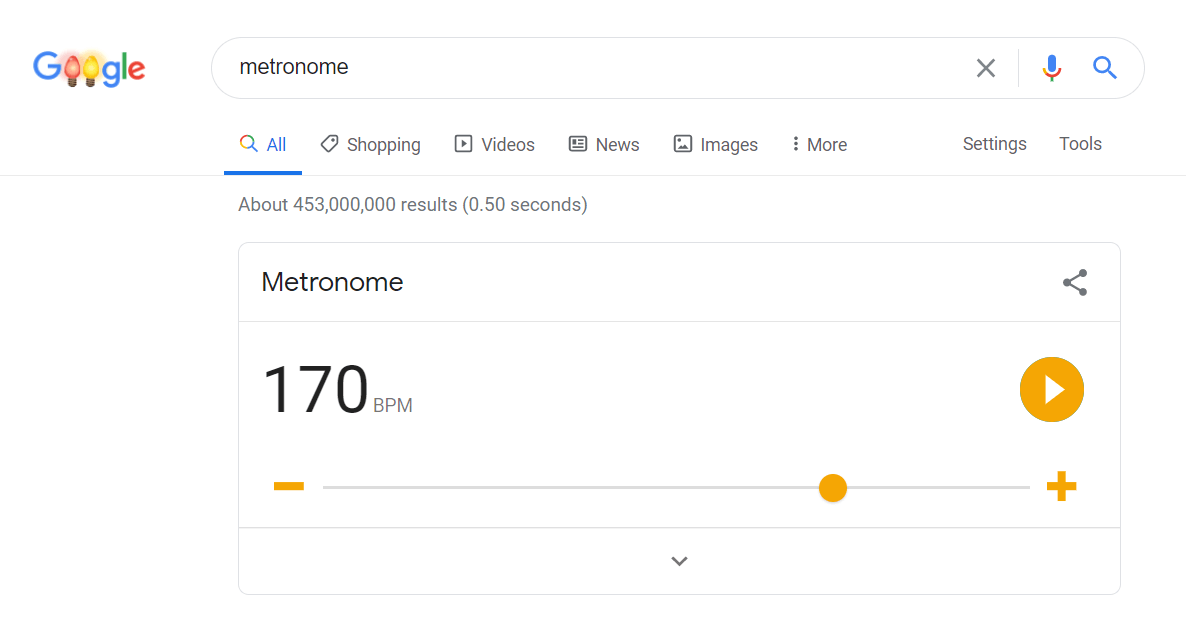
Even Google Chrome has its own metronome app when you search for the keyword.
It doesn’t have any advanced features but it does offers the very basics of what you’ll ever need in a metronome.
2. Use a down-up strumming motion
One of the most common strumming motions is the down-up strum pattern.
As the name implies, you simply strum down on the strings, then up!
This down-up pattern is the foundation of most strumming techniques, so it’s important to get comfortable with it before moving on to anything else.
For you to strum down the strings, it just means to use your picking hand (the hand that holds the pick) and brush downwards in one fluid motion.
To do an up strum, you will also need to use your picking hand, but this time brush upwards against the strings.
It’s important to use a light touch when doing this, as you don’t want to hit the strings too hard and create a jarring sound.
3. Relax your wrists and arms
Another important tip is to relax your wrists and arms while strumming.
Many beginners tend to tense up their muscles when first starting out, which can make it difficult to play smoothly.
This will be the cause of choppy strumming and/or misshits.
One way to do this is by practicing slow and steady at first, and if you remember our tip #1, you can use a metronome to do this.
As you gain more experience and become more comfortable with the motion, you can then start to increase the tempo.
Just be sure not to go too fast at first, as you might start to tense up again without realizing it.
What is the difference between cheap guitars and expensive acoustic guitars?
All of them are made of wood, right? What might potentially increase the price of a guitar over others?
Well, cheap guitars are essentially made out of cheaper materials, and expensive guitars are built using premium materials that are in better conditions.
Additionally, as I have mentioned, guitars are typically made at a price that leaves room for the builder or seller to make a profit.
In the end, a business will do business, so having a low price inevitably means having an unskilled assembly line with low-quality control.
Cheaper guitars also come with cheaper paints and finishes.
This video by Alamo Music Center is an great way to compare, side by side, how two guitars sound at two different prices:
I encourage you to watch the video since he will help you analyze the guitar’s playability, setup, tone, workmanship, hardware, and woods.
Hearing them one after the other really helps you pay attention to small details that we could otherwise ignore.
What strings are best for an acoustic guitar?
The ones I use a lot are the Elixir Strings Phosphor Bronze Acoustic Guitar Strings (link to Amazon.com).
At the same time, it currently has 5 stars on Amazon with more than 10,000 different reviews.
So this pack seems to be working very well for a lot of people.
Having said that, I don’t believe it makes sense to identify one specific pack as the “best” in this particular case.
Because everyone has distinct preferences and requirements, what works for you might not be suitable for the next person.
There are undoubtedly a variety of additional choices available that could provide you with the outcome you desire.
In my personal experience, choosing a set of strings has always included some trial and error.
I bought a pack, used it, then bought another, used that one, used another, used another, and so on, until I was able to remain with the one I liked the best.
Sounds crazy, but this wasn’t done in a year. Don’t go now and buy too many sets at the same time just to try them at once, instead, let it happen naturally over time.
In love with guitars, and gear; expert in all things music! Been writing about guitars for about 5 years and counting. Born in the ’90s. Alma Mater: University of Havana. Always curious, trying to understand the world. #TeamFender

